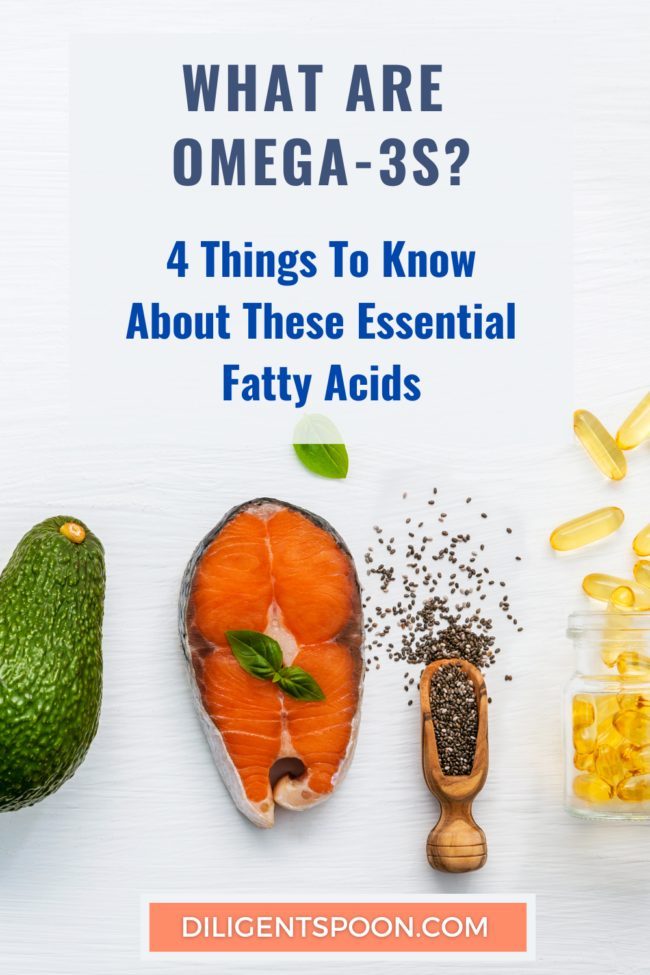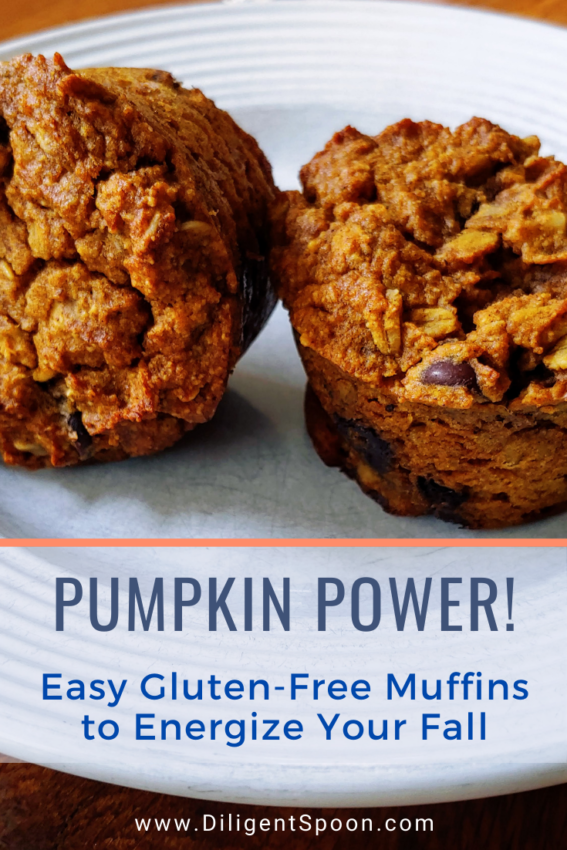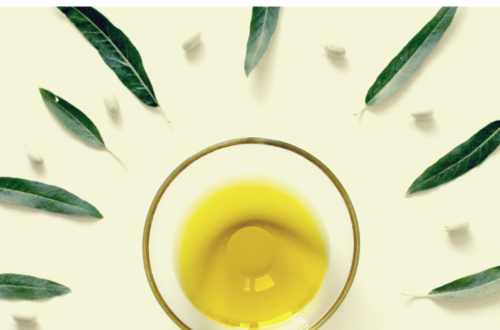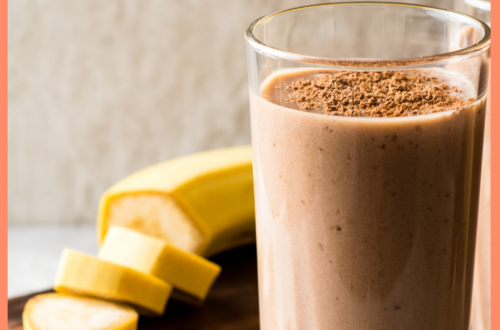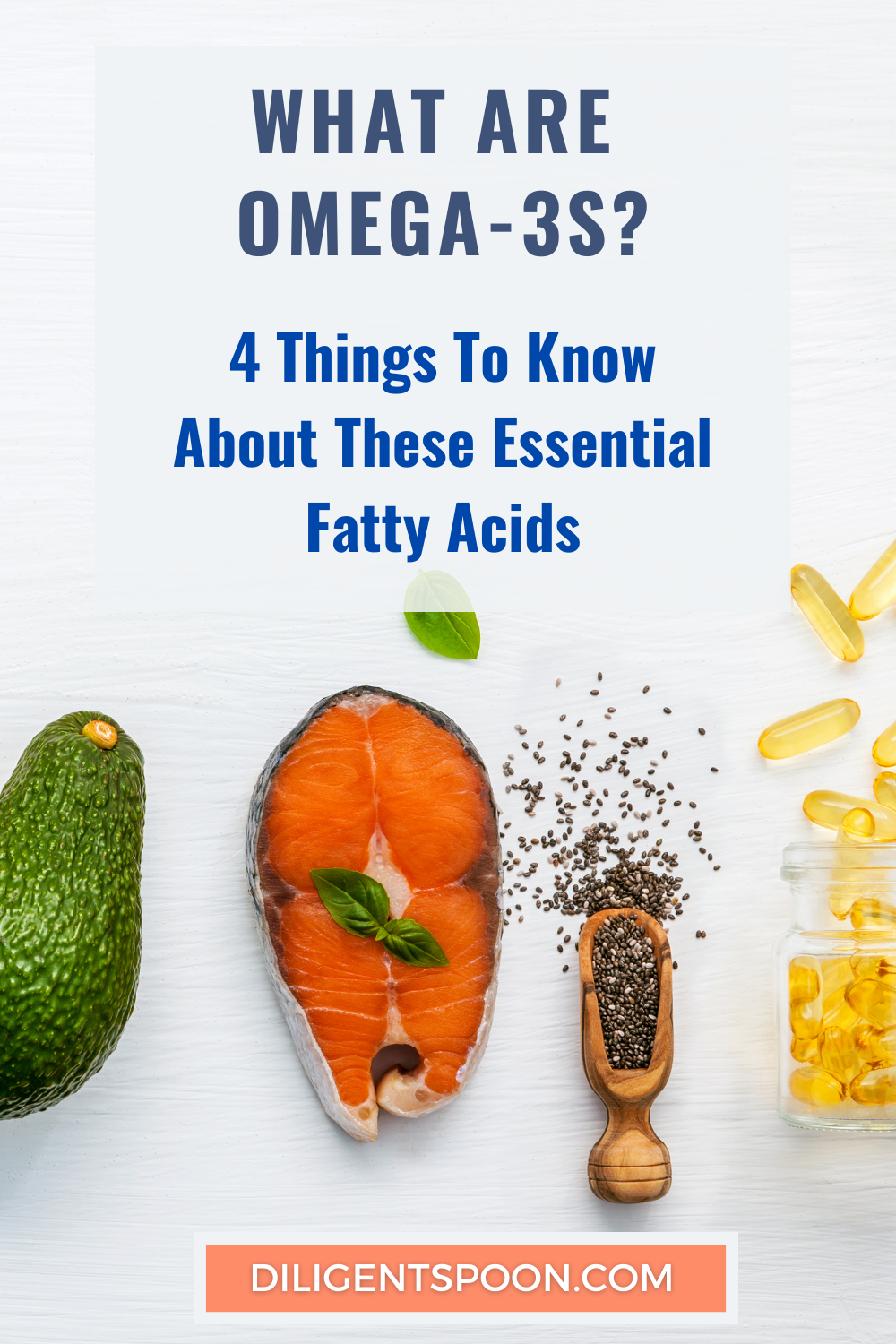
What Are Omega-3s? 4 Things You Need to Know About These Essential Fatty Acids
What are Omega-3 fatty acids, why are they important, and how do you know if are you getting enough in your diet?
You’ve probably heard about some of the health benefits of omega-3 fatty acids (sometimes written as ω−3 or n−3 fatty acids) in your diet.
These fatty acids are not only key to healthy cell structure, they also have been shown to reduce the likelihood of everything from heart disease to depression. Omega-3s are essential, meaning your body cannot make them, so you must consume them in food (or supplements). Some omega-3s are found in plant oils, while others are found in fish and seafood.
In this post, we’ll explain what omega-3 fatty acids are, why they are important, which ones are important, and how to make sure you’re getting enough for optimum health.
4 Pieces of Essential Information on Omega-3 Fatty Acids
You want to understand what omega-3 fatty acids are, why they are essential, and how to make sure you’re getting enough.
FIRST: What are Omega-3 Fatty Acids?
Omega-3 fatty acids (or n-3 FAs) are a class of polyunsaturated fatty acids, or PUFAs. (You’ve probably also heard of the other class of PUFAs, omega-6 FAs.) PUFAs, like all fatty acids, are mode of long chains of carbon atoms. However, PUFAs are different from saturated and monounsaturated fatty acids because they have two or more double bonds between carbons within the fatty acid chain.
Specifically, n-3 FAs have a carbon-carbon double bond located three carbons from the methyl end of the chain. In the image below, the “methyl end” is the end without the oxygens, or “O” atoms. The red arrows are pointing to the carbon-carbon double bond that is three carbons from the methyl end – it’s the bond that makes n-3 FAs unique from other PUFAs.
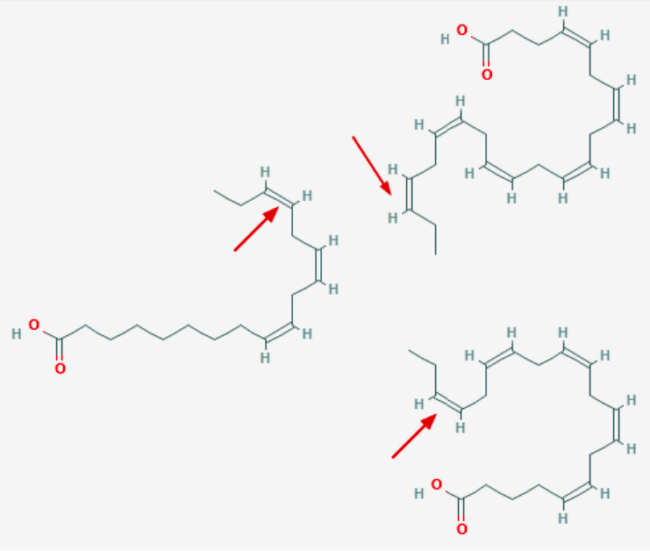
There are three main n-3 FAs: alpha-linolenic acid (ALA), eicosapentaenoic acid (EPA), and docosahexaenoic acid (DHA).
ALA is found in plant oils such as flaxseed, soybean, and canola oils, while DHA and EPA are found in the oils of marine fish (or, “fatty salt water fish” such as salmon).
ALA is considered essential, meaning your body cannot make it – you must get it from your diet. Your body can convert some ALA into EPA and DHA, the conversion rate is so low (reported between 1 – 15%) that the only practical way to increase your intake of EPA and DHA is through foods or supplements.
Why can’t your body make the n-3 fatty acid ALA? It’s because of the double carbon-carbon bond we talked about earlier. Our bodies cannot make that double bond between the 3rd and 4th carbons in the fatty acid chain.
SECOND: Why are Omega-3s Important?
Omega-3 fatty acids are essential because they make up an important structural part of our cell membranes. They are used in the cell wall of almost every cell in our body, so they are crucial to our survival. As mentioned earlier, our bodies can make a little DHA and EPA from ALA, but we cannot make ALA – that is why it is considered essential.
DHA is found in high concentrations in the brain, retina (eye), and sperm. Eicosanoids, which are made from EPA, have wide-ranging roles in our pulmonary, cardiovascular, immune, and endocrine (hormonal) systems.
A large amount of research has been done on the benefits of DHA and EPA on our health. Not surprisingly, people with higher intakes of DHA and EPA (whether from food or supplements) have less heart disease, type 2 diabetes, and lower blood pressure. More recently, researchers have learned that DHA and EPA also help with mental health issues like depression.
THIRD: How Much Omega-3s Do I Need?
Currently, there is no recommended daily allowance (RDA), or intake for n-3 fatty acids. This is because there isn’t enough data yet to estimate an average daily requirement.
Instead, the Food and Nutrition Board (FNB) has established an Adequate Intake (AI) for n-3 fatty acids as ALA. Intake at this level is assumed to ensure nutritional adequacy. (AIs are used when there is not enough evidence to create an RDA.)
The National Institutes of Health recommends that men consume 1.6 grams and women consume 1.1 grams of omega-3s daily. As you can see from the table below, specific seeds, nuts, and seed oils are excellent sources of ALA. Cold-water, or fatty fish like salmon, are excellent sources of DHA and EPA.
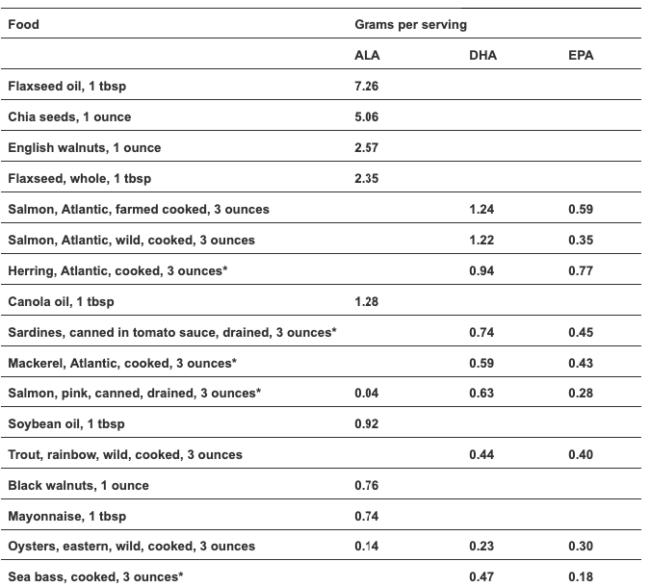
*Except as noted, the USDA database does not specify whether fish are farmed or wild caught.
Most of us get enough ALA already because we eat enough seeds, nuts, and seed oils (eg, canola oil) to provide it. However, we tend to be low in the other n-3 fatty acids DHA and EPA.
Although there is no recommended allowance for DHA and EPA, nutrition scientists generally agree that an average intake of 250 mg/day of DHA and EPA combined is beneficial for the general population. If you eat just 6 ounces of salmon or similarly fatty fish per week, you will meet this goal.
To get the maximum health benefits – reduced heart disease risk, mental health boost, and others – researchers recommend 1000 – 2000 mg/day, with 1000 mg/day coming from EPA.
FOURTH: How to Get Enough Omega-3 – Foods and Supplements
We are probably already getting enough of the omega-3 ALA, which is found in seeds and nuts. However, ⅔ of Americans don’t get enough DHA and EPA.
If you like and eat salmon (or sardines and herring) at least twice a week, you are probably getting enough DHA and EPA in your diet. Here are a few of my favorite ways to prepare salmon and sardines, whether you love fish or just want to try it:
- Pan-seared salmon. If you’ve never prepared salmon filets before, start here – this is a simple and delicious no-fail recipe.

- Sardines on salad. I love chopping up canned sardines that adding them on top of my salad, or using them to make a sardine salad (take your favorite tuna salad recipe, and substitute sardines). If you want a more structured recipe, you may like this quick Sardine and Lemongrass Salad.
- Stuffed Salmon Avocados. Canned salmon is just as nutritious as the fresh fish, less expensive, and very convenient to store. This recipe is extremely quick and nutritious. Note: Canned salmon often contains bones that you can eat or pick out (I eat the bones – they’re soft, contain calcium, and I’m too lazy to pick them out).
- Salmon Poké. Poké is my personal way to eat fish. Substitute fresh salmon for tuna in this poké recipe. Note that this is a raw fish recipe, so make sure your fish has been properly frozen and handled.
So, what if you don’t like (or can’t get) fish like salmon and sardines?
People who don’t eat seafood, including vegetarians and vegans, will have a hard time getting enough DHA and EPA in their diets. Again, our bodies can convert some ALA into DHA and EPA, but the conversion rate is very low. Fortunately, there are many omega-3 supplements that contain DHA and EPA, even vegan-friendly ones. Although food is always a preferable source of nutrients, supplements are a good way to meet specific nutritional needs.
Omega-3 supplements that contain DHA and EPA are generally from either fish- or krill-oil (animal-based), or they are derived from algal oil (algae-based). Both sources are equal nutritionally, and studies have shown that they produce the same effects in your body. The main difference is cost – algae-based DHA+EPA supplements are generally more expensive than fish or krill oil varieties.
If you’re looking to add omega-3s with supplements, here are a few that you might want to try:
Fish oil-based: You’ll get more value – higher dosages for a lower cost – with fish-based omega-3s because they are easier to manufacture.
- Nordic Naturals Omega-3, Lemon Flavor – 690 mg contains 220 mg of DHA and 330 mg of EPA
- Nature Made Omega 1000 mg softgels contain 500 mg of DHA and EPA combined
Vegan (algal oil): These two are a good value for algae-based omega-3s, vegan, and each provide at least 300 mg DHA and 150 mg EPA per serving
SUMMARY
- Omega-3 fatty acids are essential for health, we must get them from our diet, and there are three primary n-3s: ALA, DHA, and EPA.
- Most of us get plenty of the n-3 fatty acid ALA from plant sources, but we don’t get enough DHA and EPA because they are found mostly in fatty fish.
- DHA and EPA may have many protective health benefits but do not have a recommended intake. If you want to increase your intake of EPA and DHA, the best ways to do that are to eat fatty fish 2 – 3 times per week, or take a fish oil (or algae-based for vegans) supplement.
To recap, here are the issues we covered:
1. Omega-3 fatty acids are polyunsaturated fatty acids, or PUFAs, that are essential, meaning that our bodies cannot make them, so we must get n-3 FAs through our diets. The three main types of n-3s are ALA, EPA, and DHA.
2. Omega-3s are important components of the membranes that surround all the cells in our body. EPA and DHA may also protect against some chronic diseases and improve mental health.
3. Most of us eat enough of the omega-3 ALA, but do not get enough of omega-3s DHA and EPA.
4. You can increase your DHA and EPA intake by eating fatty fish or taking DHA and EPA supplements made from fish, krill, or algae oil.
After reading this post, you should now what omega-3 fatty acids are, why they are important parts of a healthy diet, whether or not your getting enough, and how to increase your intake of n-3s.
Have more questions or want to leave feedback? Let me know your thoughts in the comments below, DM through social media, or email me at [email protected].
Other Helpful Resources:
Omega-3 Fatty Acids: Fact Sheet for Health Professionals
What is the healthiest fish to eat? The best choices for you and the planet
Omega-3s for Sports Performance
Comparing Algae-Based DHA+EPA Supplements
What Is Algae Oil, and Why Do People Take It?
PIN THIS IMAGE:
